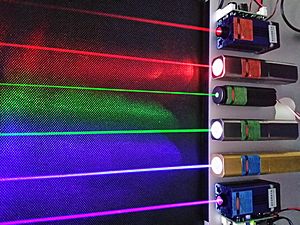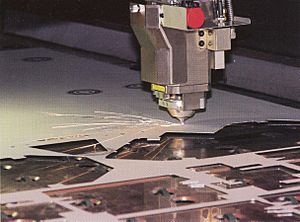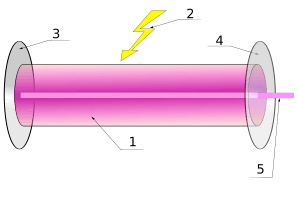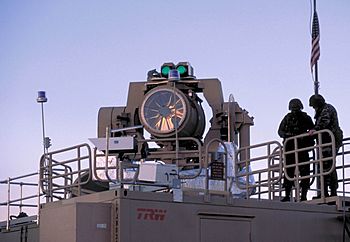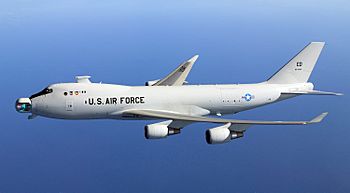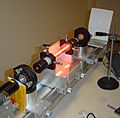Laser facts for kids
A laser is a special machine that creates a very strong, single-color beam of light. Unlike a flashlight, a laser beam stays narrow and powerful, even over long distances. It uses special materials like gases or crystals to make light of just one color. Mirrors inside the laser make this light much stronger and keep it traveling in a straight, narrow beam. When a laser beam hits something, it makes a tiny, bright spot. All the light's energy stays focused in that one beam, unlike a regular light that spreads out.
The word "laser" is actually an acronym. It stands for "light amplification by stimulated emission of radiation".
Contents
How Lasers Work
A laser creates light using a special material called an "optical gain medium". Think of this as the laser's engine. Energy is put into this material using an 'energy pump'. This energy can come from electricity, another light source, or other power sources.
This energy makes the material go into an excited state. This means the electrons in the material have extra energy. After a short time, they will lose that energy. When they lose this extra energy, they release tiny particles of light called photons. This is the "stimulated emission of radiation" part of how a laser works. The type of material used decides what color (or wavelength) the light will be.
Many things, like a light bulb, can make light. But their light spreads out in all directions. A laser controls how its light is made. This makes the light all one kind, going in one direction. This is called "coherent radiation".
At first, this light is still weak. The laser uses two mirrors on either side of the material. These mirrors bounce the light back and forth. As the light bounces, it hits other parts of the material, causing them to release more photons. This makes the light much stronger, a process called "light amplification". When all the material is producing light, it creates a very strong, narrow beam of light. This is what we call a laser beam.
Laser Design and Types
The light travels through the special material between two mirrors. These mirrors reflect the light back and forth. However, one of the mirrors only partly reflects the light. This allows some light to escape, forming the laser beam.
This is a basic design. The type of special material used usually defines the type of laser.
- Crystal Lasers: Some lasers use crystals, like ruby or a garnet crystal made of yttrium and aluminum.
- Gas Lasers: Other lasers use gases such as helium, nitrogen, carbon dioxide, or neon.
- Smallest Lasers: The smallest lasers use semiconductor diodes to make light. These are often found in electronics.
History of Lasers
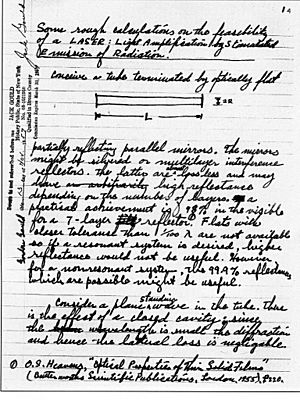
The idea behind lasers, called "stimulated emission," first came from Albert Einstein. Many years passed as scientists worked to see if this idea could actually work. At first, they succeeded in making masers, which are similar but use microwaves instead of light. Later, they figured out how to make shorter, visible wavelengths of light.
The name "laser" was created in 1959 by Gordon Gould in a research paper. The first working laser was built and operated by Theodore Maiman in 1960 at the Hughes Research Laboratories. Many people started working on lasers around this time. The question of who would get the patent for the laser was not decided until 1987, with Gordon Gould winning the rights.
Everyday Uses of Lasers
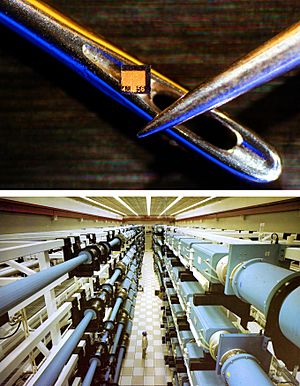
Lasers are used in many ways, both in daily life and in industries.
- Entertainment: Lasers are found in CD and DVD players. They read the digital code from the disk to play music or movies.
- Shopping: Lasers often read bar codes or SQR codes on items in stores. This helps identify products and show their prices.
- Measurement: A laser can even measure the distance from the Earth to the Moon. It does this by reflecting off special mirrors left on the Moon by the Apollo missions. By timing how long the light takes to travel there and back, scientists can find the exact distance.
- Early Uses: The first time most people saw lasers in daily life was with supermarket barcode scanners, which appeared in 1974. The laserdisc player (1978) was the first successful product with a laser for consumers. But the compact disc player (1982) was the first laser device to become truly common, soon followed by laser printers.
Some other common uses include:
- Communication: Lasers are used in fiber-optic communication and for sending signals through space.
- Industry: Strong lasers can cut metal, weld materials, mark parts, and measure things without touching them.
- Research: Scientists use lasers for many studies, like identifying materials, studying light, and creating holograms.
- Commercial Products: You can find lasers in laser pointers and some thermometers.
- Entertainment: Lasers are used in laser lighting displays at concerts and shows.
In 2004, about 131,000 non-diode lasers were sold, worth about $2.19 billion. In the same year, about 733 million diode lasers were sold, worth $3.20 billion.
Lasers in Medicine
Lasers have many important uses in medicine:
- Surgery: They are used in laser surgery, especially eye surgery like LASIK, to reshape the eye's cornea.
- Treatments: Lasers help treat kidney stones and are used in cosmetic skin treatments. These include treating acne, reducing cellulite, and removing hair.
- Diagnosis: In chemistry, lasers are used with spectroscopy to identify different materials. They can find out what gases, solids, or liquids something is made of.
Lasers as Weapons
Lasers, except for the very weakest ones, can be used to temporarily or permanently harm eyesight if aimed at the eyes. The amount of vision damage depends on the laser's power, color, and how long someone is exposed. Even a weak laser can cause permanent vision loss in certain situations. This makes them a potential non-deadly but disabling weapon.
Because of the serious harm that laser-caused blindness can create, using lasers as weapons to cause blindness is controversial. Weapons designed to cause blindness have been banned by the Protocol on Blinding Laser Weapons. There have been cases where pilots were exposed to lasers while flying. This has led aviation authorities to create special rules to deal with such dangers.
Laser weapons that can directly damage or destroy a target in combat are still mostly in the experimental stage.
In the 2000s, the United States Air Force worked on the Boeing YAL-1. This was an airborne laser mounted in a Boeing 747 airplane. It was meant to shoot down incoming ballistic missiles over enemy territory. However, the project was found to be too difficult and was canceled in 2011.
The United States Navy is also developing a laser weapon called the Laser Weapon System or LaWS.
Images for kids
-
Lidar measurements of the Moon's surface made by the Clementine mission.
-
The Mercury Laser Altimeter (MLA) from the MESSENGER spacecraft.
-
The free-electron laser FELIX at the FOM Institute for Plasma Physics Rijnhuizen, Nieuwegein.
-
A laser used in astronomical adaptive optics imaging.
See also
 In Spanish: Láser para niños
In Spanish: Láser para niños


